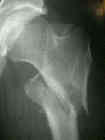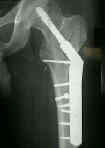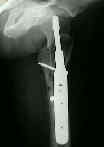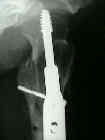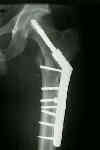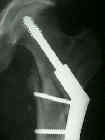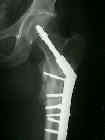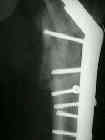- See: Unstable Intertrochanteric Fractures
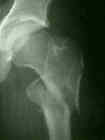
- Discussion:
- consist of an intertrochanteric frx w/ a subtroch component;
- constitutes 15% of intertroch frx;
- Treatment Options:
- sliding hip-screw or 2nd-generation locking nail may be used in rx of intertroch-subtroch frx that have femoral shaft extension;
- second-generation locking nail is an excellent form of fixation if piriformis fossa is intact;
- when piriformis fossa is not intact, rx w/ hip-screw w/ long side-plate, combined w/ limited interfragmentary fixation & bone-grafting;
- in subtroch frx that extend quite distally into shaft & that are combined w/ intertroch frx & involvement of piriformis fossa, reconstration IM nail may be only option;
- however, surgeon should anticipate difficulty in its use because starting point has been destroyed;
- in the report by Barquet A, et al, the authors identified 52 closed intertroch-
subtrochanteric fracture which underwent internal fixation with an IM nail;
- at one year, 7 patients died and 2 were lost to follow up;
- 83% of patients were restored to their preinjury status and rate of union was 100%;
- technical points: the tip of the greater troch is used as a starting point, but in cases of intertroch frx, the starting point goes directly through the fracture site;
-Intertrochanteric-subtrochanteric fractures: treatment with the long Gamma nail.
- Case Example:
- 30-year-old infantry man who sustained an intertroch/subtroch fracture during a parachute jump;
- at 8 months postop he was wt bearing as tolerated and asymptomatic, despite evidence of delayed healing of the subtrochanteric component; (bone grafting was not used in this case)


